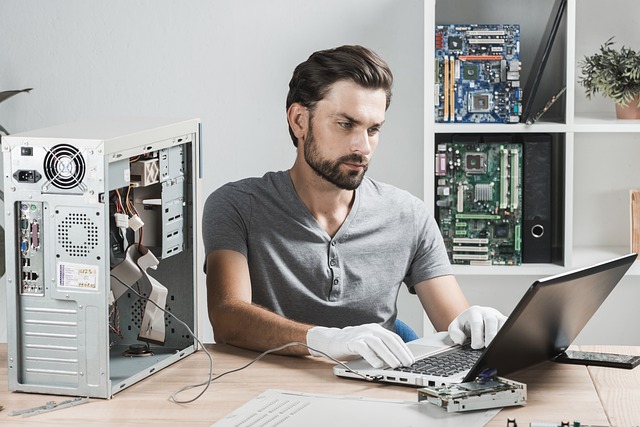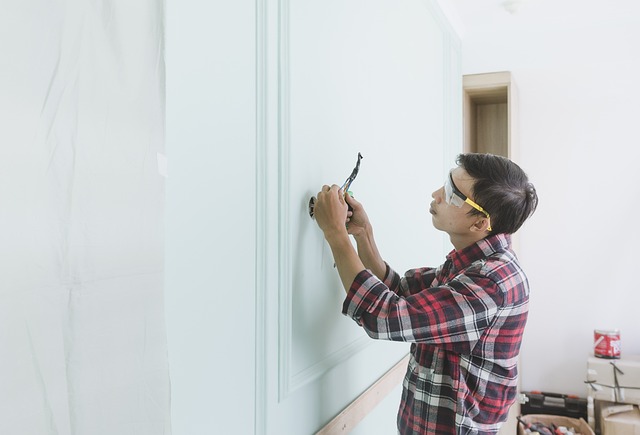Effective home repair and maintenance are critical for ensuring the safe and efficient operation of household appliances. Homeowners must understand the essential steps for proper installation, including adhering to manufacturer instructions, local building codes, and specific appliance needs to prevent electrical fires or gas leaks. It's important to measure and place appliances correctly, maintain clearance for optimal performance, and secure them to prevent movement during use. Routine maintenance like inspecting connections, cleaning filters, and tightening fasteners is key for longevity and safety. For complex installations or tasks beyond DIY capabilities, professional services should be engaged to guarantee correct setups and avoid future issues. Regular home repair and maintenance practices, as outlined, are instrumental in maintaining a safe living environment and can significantly extend the life of appliances. When troubleshooting common issues like power supply problems or mechanical failures, basic diagnostic skills and regular upkeep can prevent many malfunctions. However, for gas or complex electrical system problems, professional assistance is essential to ensure safety and correct functionality. Homeowners should consult appliance manuals for specific troubleshooting guidance and maintain a list of reputable professionals for repair needs. A proactive approach to home repair and maintenance not only keeps appliances running efficiently but also helps prevent small issues from escalating. Investing in professional repairs and adhering to a routine maintenance schedule is a key step in upholding a well-functioning home environment, ensuring safety, and protecting your investment in household appliances.
When a home’s appliances operate with precision, it’s a testament to diligent repair and maintenance practices. This article demystifies the process of appliance installation and repair, guiding readers through each step to ensure their household devices function optimally. From grasping the fundamentals of installation to troubleshooting common issues, and determining when professional expertise is necessary, this piece serves as an invaluable resource for home repair and maintenance enthusiasts seeking to tackle appliance-related tasks with confidence.
- Understanding the Basics of Appliance Installation for Home Repair and Maintenance
- Step-by-Step Guide to Safely Installing Major Household Appliances
- Troubleshooting Common Issues in Appliance Repair and Maintenance
- When to Call a Professional: Knowing the Limits of DIY Appliance Repair and Maintenance
Understanding the Basics of Appliance Installation for Home Repair and Maintenance

When addressing home repair and maintenance, particularly in relation to appliance installation and upkeep, it’s crucial to possess a foundational understanding of the process. Proper installation is not merely about connecting an appliance to power and water sources; it encompasses ensuring that each device functions safely within your living space. Homeowners embarking on DIY appliance installation projects should familiarize themselves with the manufacturer’s guidelines, local building codes, and the specific requirements of each appliance. This due diligence helps prevent potential hazards such as electrical fires or gas leaks.
Moreover, understanding the basics of appliance installation is a cornerstone of effective home repair and maintenance. It involves careful measurement and placement to avoid obstructions and ensure optimal performance. For instance, refrigerators require ample clearance for proper air circulation, while washing machines must be leveled and secured to prevent movement during operation. Regular maintenance checks, such as inspecting hose connections, cleaning filters, and tightening screws or bolts, are integral to prolonging the lifespan of your appliances and maintaining a safe home environment. Homeowners should also consider the importance of using qualified professionals for complex installations or when in doubt, to ensure that all connections and setups are performed correctly and safely. This proactive approach to home repair and maintenance can save time, money, and potentially avoid costly repairs down the line.
Step-by-Step Guide to Safely Installing Major Household Appliances

When installing major household appliances, safety and precision are paramount to ensure proper function and longevity. Begin by carefully reading the manufacturer’s manual for specific instructions tailored to your appliance model. This guide will outline necessary steps, safety precautions, and voltage requirements. Next, shut off the power to the relevant circuit breaker or disconnect the power source entirely to prevent electric shock during installation. For gas-powered appliances, turn off the gas supply valve and ensure the area is well-ventilated.
Proper placement is crucial; choose a location that allows for ventilation if necessary, and consider the proximity to water and electrical sources to avoid hazards. Securely anchor the appliance to prevent movement that could cause damage or injury. Connect electrical wires according to the manual’s diagrams, ensuring secure and safe connections without overloading circuits. For water-connected appliances like refrigerators with ice makers or washing machines, connect water supply lines to the nearest shut-off valve, making sure all connections are leak-free. Finally, once all connections are made, restore power slowly and check for proper operation. If any aspect of installation seems beyond your comfort level or expertise, it’s wise to consult a professional to avoid complications in home repair and maintenance. Regular checks and prompt repairs can extend the life of your appliances and maintain the safety and efficiency of your household.
Troubleshooting Common Issues in Appliance Repair and Maintenance

When appliances malfunction, timely troubleshooting is key to maintaining a smoothly functioning household. Common issues such as electrical faults, water leaks, or mechanical failures can often be resolved with basic diagnostic skills and preventive maintenance practices. For instance, if an appliance isn’t powering on, checking the power source, outlet, and circuit breaker can quickly identify whether the problem is a simple as a tripped switch. Similarly, routine cleaning and inspection of parts like filters, seals, and hoses can preemptively address potential malfunctions before they escalate. In cases where issues are more complex, such as with gas-powered appliances or those involving intricate electrical systems, professional assistance is advisable to avoid safety risks. Regular maintenance, including tightening connections, lubricating moving parts, and verifying proper drainage, can extend the lifespan of your appliances and prevent minor issues from becoming costly repairs. Homeowners should familiarize themselves with their appliance manuals for specific troubleshooting steps and keep a list of qualified repair professionals on hand for when professional intervention is necessary. By staying proactive with home repair and maintenance, homeowners can ensure that their appliances operate efficiently and safely for years to come.
When to Call a Professional: Knowing the Limits of DIY Appliance Repair and Maintenance

When encountering issues with home appliances, discerning when to tackle a repair yourself and when to call in professional help is crucial for both safety and effectiveness. DIY appliance repairs can be rewarding, especially for minor glitches like a loose wire or a clogged filter. However, more complex problems such as gas leaks, electrical complications, or significant malfunctions often demand the expertise of licensed professionals. These specialists are trained to handle potentially hazardous situations and possess the tools and knowledge to ensure that repairs are not only effective but also up to code. Regular maintenance, a key aspect of home repair and maintenance, can prevent many issues from arising in the first place. Professionals can provide comprehensive service checks that cover everything from cleaning condenser coils to inspecting water lines, ensuring your appliances operate at peak efficiency. By understanding the limits of DIY capabilities and recognizing when professional intervention is necessary, homeowners can protect their investments, maintain safety within the household, and extend the lifespan of their appliances. Engaging with experts for complex repairs and routine maintenance is a smart investment that contributes to the overall well-being of your home environment.
When it comes to maintaining the efficiency and longevity of your household appliances, a combination of DIY knowledge and professional expertise is invaluable. This article has outlined the fundamental aspects of appliance installation, offering a comprehensive guide for safe and effective integration of major home appliances. By troubleshooting common issues, homeowners can address many minor repairs independently, fostering a proactive approach to home repair and maintenance. However, recognizing the boundaries of your competence is crucial; knowing when to call in a professional ensures that complex problems are handled safely and correctly. With the insights provided, you are now equipped to manage your appliances more effectively, thereby enhancing the overall functionality and comfort of your home.
